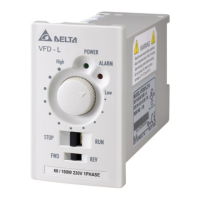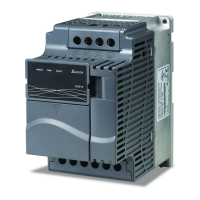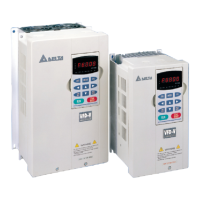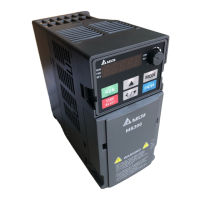Pr. Functions Settings
Factory
Setting
2-04 Reverse operation
inhibit
d0: Enable reverse
d1: Disable reverse
d2: Disable forward
d0
2-05 ACI (4 ~ 20mA)
input loss detection
d0: Decel to 0Hz
d1: Stop immediately, display EF
d2: Run with the last freq.
d0
2-06 Line Start Lockout d0: Enable d1: Disable d0
Group 3: Output Function Parameters
Pr. Functions Settings
Factory
Setting
3-00 Desired freq. attained d1.0 ~ d400 Hz d1.0
3-01 Terminal count value d0 ~ d999 d0
3-02 Preliminary count
value
d0 ~ d999 d0
3-03 Multi-function (relay
output)
d0: not used
d1: AC drive operational
d2: Max. Output Freq. Attained
d3: Zero Speed
d4: Over Torque
d5: Base-Block (B.B.)
d6: Low Voltage Detection
d7: AC Drive Operation Mode
d8: Fault Indication
d9: Desired Freq. Attained
d10: PLC Program Running
d11: PLC Program Step Complete
d12: PLC Program Complete
d13: PLC Program Operation Pause
d14: Terminal Count Value Attained
d15: Preliminary Count Value Attained
d16: Ready State Indicator
d8
Group 4: Input Function Parameters
Pr. Functions Settings
Factory
setting
a4-00
Potentiometer bias
freq.
d0.0~d350Hz d0.0
a4-01
Potentiometer bias
polarity
d0: positive bias
d1: negative bias
d0
a4-02
Potentiometer freq.
gain
d1~d200%
d100
4-03
Potentiometer
reverse motion
enable
d0: not used
d1: reverse motion enable
d2: forward motion only
d0
4-04
Multi-function input
terminal1 (M1)
(d 0~d 20)
d1
4-05
Multi-function input
terminal 2(M2)
d6
4-06
Multi-function input
terminal 3(M3)
(d 0, d 4~d 20)
d0: not used
d1: M0: FWD/STOP, M1: REV/STOP
d2: M0: RUN/STOP, M1: FWD/REV
d3: M0, M1, M2: 3-wire operation control
mode
d4: External fault, normally open (N.O.)
d5: External fault, normally closed (N.C.)
d6: RESET
d7: multi-step speed command 1
d8: multi-step speed command 2
d9: jog operation
d10: accel/decel speed inhibit
d11: first or second accel/decel time
selection
d12: base-block (B.B.),normally open (N.O.)
d13: base-block (B.B.),normally closed (N.C)
d14: increase master freq.
d15: decrease master freq.
d16: run PLC program
d17: pause PLC
d18: counter trigger signal
d19: counter reset
d20: select ACI/deselect AVI
d7
Group 5: Multi-step Speed and PLC Parameters
Pr. Functions Settings
Factory
Setting
5-00 1
st
step speed freq. d0.0 ~ d400Hz d0.0
5-01 2
nd
step speed freq. d0.0 ~ d400Hz d0.0
5-02 3
rd
step speed freq. d0.0 ~ d400Hz d0.0
5-03 PLC mode d0: Disable PLC operation
d1: Execute one program cycle
d2: Continuously execute program cycles
d3: Execute one program cycle step by step
(separate by STOP)
d4: Continuously execute one program cycle
step by step (separate by STOP)
d0
5-04 PLC forward/reverse
motion
d0 ~ d15 (d0: Forward, d1: Reverse) d0
5-05 Time duration step 0 d0 ~ d65500 Sec d0
5-06 Time duration step 1 d0 ~ d65500 Sec d0
5-07 Time duration step 2 d0 ~ d65500 Sec d0
5-08 Time duration step 3 d0 ~ d65500 Sec d0
Group 6: Protection Parameters
Pr. Functions Settings
Factory
Setting
6-00
Over-Voltage
Prevention Level
d0:disable
d350~d410V
d390
Pr. Functions Settings
Factory
Setting
6-01 Over-current
Prevention Level
d0: disable
d20~d200%
d170
6-02
Over-torque detection
d0:disable
d1:enabled during constant speed operation
and continues until the continuous limit is
reached.
d2:enabled during constant speed operation
and halted after detection.
d3:enabled during accel and continues
before continuous output time limit is
reached.
d4:enabled during accel and halted after
over-torque detection.
d0
6-03
Over-torque detection
level
d30 ~ d200% d150
6-04
Over-torque detection
time
d0.1 ~ d10.0 Sec d0.1
6-05 Electronic thermal
overload relay
d0: Not used
d1: Act with standard motor
d2: Act with special motor
d0
6-06
Electronic thermal
characteristic
d30~d600 Sec d60
6-07 Present fault record
6-08
Second most recent
fault record
6-09
Third most recent fault
record
6-10
Forth most recent fault
record
6-11
Fifth most recent fault
record
6-12
Sixth most recent fault
record
d0: No fault occurred
d1: oc (over current)
d2: ov (over voltage)
d3: oH (over heat)
d4: oL (over load)
d5: oL1 (electronic thermal)
d6: EF (external fault)
d7: Reserved
d8: Reserved
d9: ocA (current exceed during acceleration)
d10: ocd (current exceed during
deceleration)
d11: ocn (current exceed during steady state)
d0
Group 7: Motor Parameters
Pr. Functions Settings
Factory
Setting
a7-00
Motor rated current d30~d120 % d85
a7-01
Motor no-load current d0 ~ d90 % d50
a7-02
Torque compensation d0 ~ d10 d1
a7-03
Slip compensation d0.0 ~ d10.0 d0.0
Group 8: Special Parameters
Pr. Functions Settings
Factory
Setting
8-00 DC braking voltage level d0 ~ d30% d0
8-01
DC braking time during
start-up
d0.0 ~ d60.0 Sec d0.0
8-02
DC braking time during
stopping
d0.0 ~ d60.0 Sec d0.0
8-03 Start-point for DC braking d0.0 ~ d400.0 Sec d0.0
8-04 Momentary power loss d0: Stop operation after momentary
power loss.
d1: Continues after momentary power
loss, speed search starts with
master freq.
d2: Continues after momentary power
loss, speed search starts with min.
output freq.
d0
8-05
Max. allowable power loss
time
d0.3 ~ d5.0 Sec d2.0
8-06 B.B. time for speed search d0.3~d5.0 Sec d0.5
8-07
Max. speed search current
level
d30~d200% d150
8-08 Skip freq. 1 upper bound d0.0~d400 Hz d0.0
8-09 Skip freq. 1 lower bound d0.0~d400 Hz d0.0
8-10 Skip freq. 2 upper bound d0.0~d400 Hz d0.0
8-11 Skip freq. 2 lower bound d0.0~d400 Hz d0.0
8-12 Skip freq. 3 upper bound d0.0~d400 Hz d0.0
8-13 Skip freq. 3 lower bound d0.0~d400 Hz d0.0
8-14 Auto restart after fault d0~d10 d0
8-15 AVR function d0: AVR function enable
d1: AVR function disable
d2: AVR function disable when decel
d2
8-16 Dynamic braking voltage d350 ~ d450V d380
8-17
DC braking lower bound
limit
d0.0 ~ d400 Hz d0.0
Group 9: Communication Parameters
Pr. Functions Settings
Factory
Setting
a9-00 Communication address d1 ~ d247 d1
a9-01 Transmission speed d0: Baud rate 4800
d1: Baud rate 9600
d2: Baud rate 19200
d1
a9-02 Transmission fault
treatment
d0: Warn and continue running
d1: Warn and ramp to stop
d2: Warn and coasting stop
d3: No warn and keep running
d0
a9-03
Modbus communication
watchdog timer
d0: Disable
d1~d20: 1 ~ 20 Sec
d0
Pr. Functions Settings
Factory
Setting
a9-04
Communication protocol
ASCII mode
d0: 7,N,2
d1: 7,E,1
d2: 7,O,1
d3: 8,N,2
d4: 8,E,1
d5: 8,O,1
RTU mode
d6: 8,N,2
d7: 8,E,1
d8: 8,O,1
d0
5 Troubleshooting and Fault Information
The VFD-L AC drive has a comprehensive fault diagnostic system that
includes several different alarms and fault messages. Once a fault is detected,
the corresponding protective functions will be activated. The following faults
are displayed on the AC drive digital keypad. The six most recent faults can be
read on the digital keypad display by viewing Pr.6-07 to Pr.6-12.
NOTE: faults can be cleared by pressing the Reset key on the keypad or Input
Terminal.
Common Problems and Solutions
Fault
Name
Fault Descriptions
Corrective Actions
The AC drive detects an
abnormal increase in
current.
1. Check whether the motors horsepower
corresponds to the AC drive output power.
2. Check the wiring connections between the AC
drive and motor for possible short circuits.
3. Increase the Acceleration time (Pr.1-09,
Pr.1-11).
4. Check for possible excessive loading
conditions at the motor.
5. If there are any abnormal conditions when
operating the AC drive after the short-circuit is
removed, the drive should be sent back to
manufacturer.
The AC drive detects
that the DC bus voltage
has exceeded its
maximum allowable
value.
1. Check whether the input voltage falls within
the rated AC drive input voltage.
2. Check for possible voltage transients.
3. Bus over-voltage may also be caused by
motor regeneration. Increase the decel time.
The AC drive
temperature sensor
detects excessive heat.
1. Ensure that the ambient temperature falls
within the specified temperature range.
2. Make sure that the ventilation holes are not
obstructed.
3. Remove any foreign objects on the heat sink
and check for possible dirty heat-sink fins.
4. Provide enough spacing for adequate
ventilation.
The AC drive detects
that the DC bus voltage
has fallen below its
minimum value.
Check whether the input voltage falls within the
rated AC drive’s input voltage.
Internal electronic
overload trip
1. Check for possible motor overload.
2. Check electronic thermal overload setting.
3. Increase motor capacity.
4. Reduce the current level so that the drive
output current does not exceed the value set
by the Motor Rated Current Pr.7-00.
The external terminal
EF-GND goes from OFF
to ON.
When external terminal EF-GND is closed, the
output will be turned off. (under N.O.E.F.)
Motor overload. Check
the parameter settings
( Pr.6-03 to Pr.6-05)
1. Reduce the motor load.
2. Adjust the over-torque detection setting to an
appropriate setting.
Over-current during
acceleration:
1. Short-circuit at motor
output.
2. Torque boost too high.
3. Acceleration time too
short.
4. AC drive output
capacity is too small.
1. Check for possible poor insulation at the
output line.
2. Decrease the torque boost setting in Pr.7-02.
3. Increase the acceleration time.
4. Replace with the AC drive with one that has a
higher output capacity (next HP size).
Over-current during
deceleration:
1. Short-circuit at motor
output.
2. Deceleration time too
short.
3. AC drive output
capacity is too small.
1. Check for possible poor insulation at the
output line.
2. Increase the deceleration time.
3. Replace with the AC drive with one that has a
higher output capacity (next HP size).
External Base Block.
AC drive output is
turned off.
1. When the external input terminal (B.B) is
active, the AC drive output will be turned off.
2. Disable this connection and the AC drive will
begin to work again.
Over-current during
steady state operation:
1. Short-circuit at motor
output.
2. Sudden increase in
motor loading.
3. AC drive output
capacity is too small.
1. Check for possible poor insulation at the
output line.
2. Check for possible motor stall.
3. Replace with the AC drive with one that has a
higher output capacity (next HP size).
Fault
Name
Fault Descriptions
Corrective Actions
Internal memory IC can
not be programmed.
1. Switch off power supply.
2. Check whether the input voltage falls within
the rated AC drive input voltage.
3. Switch the AC drive back on.
Internal memory IC can
not be read.
1. Check the connections between the main
control board and the power board.
2. Reset drive to factory defaults.
Drive’s internal circuitry
abnormal.
1. Switch off power supply.
2. Check whether the input voltage falls within
the rated AC drive input voltage. Switch on
the AC drive.
Auto accel/decel failure
Don’t use the function of auto acceleration/
deceleration.
Hardware protection
failure
Return to the factory.
Software protection
failure
Return to the factory.
Communication Error
1. Check the connection between the AC drive
and computer for loose wires.
2. Check if the communication protocol is
properly set.
The AC drive detects
excessive drive output
current.
1. Check whether the motor is overloaded.
2. Reduce torque compensation setting as set in
Pr.7-02.
3. Increase the AC drive’s output capacity.
Note: The AC drive can withstand up to 150% of
the rated current for a maximum of 60 seconds.
6 Standard Specifications
Voltage Class 115V 230V
Model Number
VFD-XXXLXXA/B
002 004 002 004 007 015
Applicable Motor Output (kW) 0.2 0.4 0.2 0.4 0.7 1.5
Rated Output Capacity
(KVA)
0.6 1.0 0.6 1.0 1.6 2.7
Rated Output Current (A) 1.6 2.5 1.6 2.5 4.2 7.0
Max. Output Voltage (V)
3-phase
corresponds
to double
input voltage
Three-phase corresponds to input
voltage
Output Rating
Rated Frequency (Hz) 1.0~400Hz
Rated Input Current (A) 6 9 4.9/1.9 6.5/2.7 9.7/5.1 Ì/9
Input voltage Tolerance
Single phase
90~132V
50/60Hz
Single / 3-phase
180~264V 50/60Hz
3-phase
180~264V
50/60Hz
Power
Frequency tolerance
±5%
Control system
SVPWM (Sinusoidal Pulse Width Modulation, carried
frequency 3kHz~10kHz)
Output Frequency
Resolution
0.1Hz
Torque Characteristics
Including the auto-torque, auto-slip compensation,
starting torque can be 150% at 5 Hz
Overload Endurance 150% of rated current for 1 minute
Accel/Decel Time 0.1~600Sec. (can be set individually)
V/F pattern V/F pattern adjustable
Control Characteristics
Stall Prevention Level 20~200%, setting of Rated Current
Keypad
Setting by ▲▼ keys or V.R
Frequency
Setting
External
Signal
Potentiometer-5KΩ/0.5W, DC 0 ~ +10V (input
impedance 47KΩ), 4~20mA (output impedance
250Ω), multi-function inputs1 to 3 (3steps, JOG,
UP/DOWN command), communication setting
Operation
Setting
Keypad Setting by RUN//STOP keys
Signal
External
Signal
M0,M1,M2,M3 can be combined to offer various
modes of operation, RS-485 communication port
Multi-function Input Signal
Multi-step selection 0 to 3, Jog, accel/decel inhibit,
first/second accel/decel switch, counter, PLC
Operation, external Base Block (NC,NO) selection
Operating Characteristics
Multi-function Output Signal
AC Drive Operating, Frequency Attained, Non-zero
speed, Base Block, Fault Indication, Local/Remote
indication, PLC Operation indication.
Other Function
AVR, S-curve, Over-Voltage Stall Prevention, DC
Braking, Fault Records, Adjustable Carried
Frequency, Starting Frequency Setting of DC
Braking , Over-Current Stall Prevention, Momentary
Power Loss restart, Reverse Inhibition, Frequency
Limits, Parameter Lock/Reset
Protection
Over Voltage, Over Current, Under Voltage,
Overload, Electronic thermal, Overheating,
Self-testing
Other Including EMI Filter
Cooling Forced air-cooling
Installation Location
Altitude 1,000 m or below, keep from corrosive
gasses, liquid and dust
Ambient Temperature
-10℃-40℃ (Non-Condensing and not frozen)
Storage Temperature
-20℃ to 60℃
Ambient Humidity Below 90%RH (non-condensing)
Environment
Vibration
9.80665m/s
2
(1G) less than 20Hz, 5.88m/s
2
(0.6G) at
20 to 50Hz
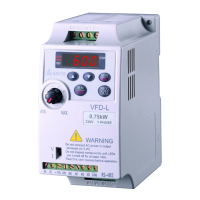
